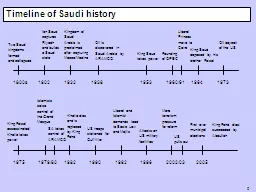/


kingdoms formed and collapsed Timeline of Saudi history 1800s 1902 1932 1938 1953 196061 1964 1973 1975 197980 1982 1990 1992 1996 200203 2005 Ibn Saud captures Riyadh and builds ID: 594104
Download Presentation The PPT/PDF document "0 Two Saudi" is the property of its rightful owner. Permission is granted to download and print the materials on this web site for personal, non-commercial use only, and to display it on your personal computer provided you do not modify the materials and that you retain all copyright notices contained in the materials. By downloading content from our website, you accept the terms of this agreement.
Slide1
0
Two Saudikingdomsformedand collapsed
Timeline of Saudi history
1800s 1902 1932 1938 1953 1960/61 1964 1973
1975 1979/80 1982 1990 1992 1996 2002/03
2005
Ibn Saud
captures
Riyadh
and builds
a Saudi
state
Kingdom of
Saudi
Arabia is
proclaimed
after capturing
Mecca/Medina
Oil is
discovered in
Saudi Arabia by
ARAMCO
King Saud
takes power
Founding
of OPEC
Liberal
Princes
move to
Cairo
King Saud
deposed by his
brother Faisal
Oil boycott of the US
King Faisalassassinated/Khalid takespower
Islamistsseizecontrol ofthe GrandMosque
SA takescontrol ofARAMCO
Khalid diesand isreplacedby KingFahd
US troopsstationed forGulf War
Moreterrorism/pressurefor reform
USpulls out
First evermunicipalelections
King Fahd dies/succeeded byAbdullah
Liberal andIslamistdemands leadto Basic Lawand Majlis
Attacks on
US military
facilitiesSlide2
1
Saudi political institutions
State developmentNo direct experience with colonialismEarly political institutions were tribal and
extremely informalImportance of the king and tribal customs
Council of MinistersThe place where the next in line to rule have a power base
Key ministries are controlled by the royal familyMajlis al-Shura
Developed as part of the basic law of 1992Started as 60 members, and ultimately increased to 150 membersRole: questions cabinet members and provides advice on decisions
CourtsDeveloped based on the
shari’a and give out hudud punishments like beheading, amputations, and flogging
Municipal councils2005
and 2011 elections filled ½ of municipal councils2% of the population voted in 2011
Approve local budgets, suggest planning regulations, and oversee building projects
King Abdullah
The “cautious reformer”Slide3
2
Family and distributive politics in Saudi Arabia
The family-run stateA’iliyya: familialism
Politics as doing what is right for the whole Saud familyPolitical relationships are based on promises of protection, a recognition of interdependence, and accountability to the family
To get things done, you need a powerful sponsor The reputation of the family is exceptionally important as it can be traded as currency
Distributive politicsOil wealth is distributed through the family across prominent families and reinforces family reputations
A group in the middle class is sponsored by a royal family member—they work to prevent further access to the royal distributive networkJobs are given out by sponsors, not often by interviews
Headquarters of Saudi AramcoSlide4
3
Religion and politics in Saudi Arabia
The Wahhabi allianceEarly alliance with a Wahhabi tradition of conservative politics
Saud alliance with the pious Sheikh family
Role of the ulemaProvide religious advice to the ruling family
Issue legal judgments “fatwas” in support of the ruling familyExample: fatwa given at request of the royal family to execute those who took over the Grand Mosque in 1979
Religious committeesCommittee for the Promotion of Virtue and Suppression of ViceMorality police that work to find and punish violations of
shari’a Fear as social control
Hajj/Great Mosque committeesSlide5
4
Liberal and religious dissent
Shi’a riotsMinority Shi’a riots in the Eastern provinces
Iranian-sponsored Shi’a riots during the hajj on several occasions in the 1980s
Khomeini’s request for Shi’a to overthrow the Saudi state
Liberal dissentLiberal petition “letter of demands” (1992)Women’s drive-in
Recent women’s activismMemorandum of Advice (1992)Islamist critique of:
Ulema as subservient to ruling familyLack of full application of the
shari’aWestern-oriented foreign policyPoor application of Islamic finance; skewed distribution of oil wealth
Islamist radicalism
Found the presence of US troops as a key objectionRepresented foremost by al-Qa’ida
Bombed US barracks, attacks on foreigners in the kingdomState response balances repression and “
rehabilitiation”Slide6
5
The Future of Saudi Arabia
Will the government liberalize?
How will the country deal with Islamist challenges?
Will the country maintain its dependence on oil?
Can traditional Saudi culture be maintained?
What role will the country play in broader Arab affairs?
Key Issues